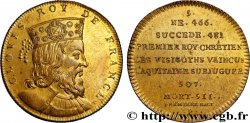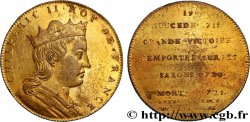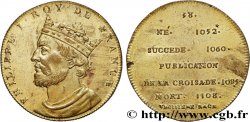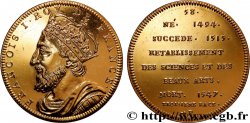E-auction 636-637543 - fme_1018730 - SÉRIE MÉTALLIQUE DES ROIS DE FRANCE Médaille, François Ier - 58 - refrappe ultra-moderne
Devi Sign-in ed essere un offerente approvato fare un'offerta, Login per fare offerte. Conti sono soggetti ad approvazione e di approvazione sono raggiunti entro 48 ore. Non aspettare fino al giorno di una vendita si chiude per registrarti.Confermando la tua offerta su questo oggetto ti impegni ad un contratto legalmente vincolante per l'acquisto di questo prodotto e fare clic su «offerta» costituisce accettazione dei termini di utilizzo de e-auctions cgb.fr.
Offerta deve essere collocato in euro gli importi interi vendita only.The si chiuderà al momento sulla descrizione dell'oggetto, eventuali offerte pervenute al sito dopo l'orario di chiusura non verranno eseguite. Volte transmition possono variare e le offerte potrebbero essere respinto se si attende per gli ultimi secondi. Per ulteriori informazioni ckeck le FAQ.
SENZA COSTI PER GLI ACQUIRENTI.
SENZA COSTI PER GLI ACQUIRENTI.
| Valutazione : | 20 € |
| Prezzo : | 3 € |
| Offerta maxima : | 7 € |
| Data di fine vendita : | 23 giugno 2025 20:19:40 |
| partecipanti : | 2 partecipanti |
Tipo : Médaille, François Ier - 58 - refrappe ultra-moderne
Data: n.d.
Metallo : bronzo dorato
Diametro : 32 mm
Asse di coniazione : 12 h.
Peso : 21,15 g.
Orlo : Cannelée
Marchio : corne d’abondance
Grado di rarità : R2
Commenti sullo stato di conservazione:
Patine hétérogène avec des traces de manipulation et rayures
Diritto
Titolatura diritto : FRANCOIS I ROY DE FRANCE..
Descrittivo diritto : Buste couronné à gauche.
Rovescio
Titolatura rovescio : 58. / NÉ 1494. / SUCCEDE 1515. / RETABLISSEMENT / DES SCIENCES ET DES / BEAUX ARTS. / MORT. 1547. / TROISIEME RACE. / P..
Descrittivo rovescio : Légende en huit lignes et corne d’abondance à l’exergue.
Commento
Médaille conservée sous capsule et dorée à l’or fin. Refrappe ultra-moderne des séries de jetons.
François Ier (1494 – 1547), dit le Père et Restaurateur des Lettres, le Roi Chevalier, le Roi Guerrier, le Grand Colas, le Bonhomme Colas ou encore François au Grand Nez, est sacré roi de France le 25 janvier 1515 dans la cathédrale de Reims, et règne jusqu’à sa mort en 1547. Fils de Charles d’Angoulême et de Louise de Savoie, il appartient à la branche de Valois-Angoulême de la dynastie capétienne.
François Ier est considéré comme le monarque emblématique de la période de la Renaissance française[2]. Son règne permet un développement important des arts et des lettres en France. Sur le plan militaire et politique, le règne de François Ier est ponctué de guerres et d’importants faits diplomatiques.
Il a un puissant rival en la personne de Charles Quint et doit compter sur les intérêts diplomatiques du roi Henri VIII d’Angleterre toujours désireux de se positionner en allié de l’un ou l’autre camp. François Ier enregistre succès et défaites mais interdit à son ennemi impérial de concrétiser ses rêves, dont la réalisation toucherait l’intégrité du royaume. L'antagonisme des deux souverains catholiques a de lourdes conséquences pour l’Occident chrétien: il facilite la diffusion de la Réforme naissante et surtout permet à l'Empire ottoman de s'installer aux portes de Vienne en s'emparant de la quasi-totalité du royaume de Hongrie.
Pour la suite de sa biographie, voir http://fr.wikipedia.org/wiki/Fran%C3%A7ois_Ier_de_France.
Medal preserved in a capsule and gilded with fine gold. Ultra-modern re-minting of token series.
Francis I (1494 – 1547), known as the Father and Restorer of Letters, the Knight King, the Warrior King, the Great Colas, the Good Man Colas or Francis with the Big Nose, was crowned King of France on January 25, 1515 in the cathedral of Reims, and reigned until his death in 1547.. Son of Charles of Angoulême and Louise of Savoy, he belongs to the Valois-Angoulême branch of the Capetian dynasty.
Francis I is considered the emblematic monarch of the French Renaissance period[2]. His reign allowed for significant development of the arts and literature in France. On the military and political level, the reign of François I was punctuated by wars and important diplomatic events..
He has a powerful rival in the person of Charles V and must count on the diplomatic interests of King Henry VIII of England, always eager to position himself as an ally of one camp or the other.. Francis I recorded successes and defeats but forbade his imperial enemy from realizing his dreams, the realization of which would affect the integrity of the kingdom.. The antagonism between the two Catholic sovereigns had serious consequences for the Christian West: it facilitated the spread of the nascent Reformation and, above all, allowed the Ottoman Empire to establish itself at the gates of Vienna, seizing almost the entire Kingdom of Hungary..
For the rest of his biography, see http://fr. Wikipedia. org/wiki/Fran%C3%A7ois_Ier_de_France
François Ier (1494 – 1547), dit le Père et Restaurateur des Lettres, le Roi Chevalier, le Roi Guerrier, le Grand Colas, le Bonhomme Colas ou encore François au Grand Nez, est sacré roi de France le 25 janvier 1515 dans la cathédrale de Reims, et règne jusqu’à sa mort en 1547. Fils de Charles d’Angoulême et de Louise de Savoie, il appartient à la branche de Valois-Angoulême de la dynastie capétienne.
François Ier est considéré comme le monarque emblématique de la période de la Renaissance française[2]. Son règne permet un développement important des arts et des lettres en France. Sur le plan militaire et politique, le règne de François Ier est ponctué de guerres et d’importants faits diplomatiques.
Il a un puissant rival en la personne de Charles Quint et doit compter sur les intérêts diplomatiques du roi Henri VIII d’Angleterre toujours désireux de se positionner en allié de l’un ou l’autre camp. François Ier enregistre succès et défaites mais interdit à son ennemi impérial de concrétiser ses rêves, dont la réalisation toucherait l’intégrité du royaume. L'antagonisme des deux souverains catholiques a de lourdes conséquences pour l’Occident chrétien: il facilite la diffusion de la Réforme naissante et surtout permet à l'Empire ottoman de s'installer aux portes de Vienne en s'emparant de la quasi-totalité du royaume de Hongrie.
Pour la suite de sa biographie, voir http://fr.wikipedia.org/wiki/Fran%C3%A7ois_Ier_de_France.
Medal preserved in a capsule and gilded with fine gold. Ultra-modern re-minting of token series.
Francis I (1494 – 1547), known as the Father and Restorer of Letters, the Knight King, the Warrior King, the Great Colas, the Good Man Colas or Francis with the Big Nose, was crowned King of France on January 25, 1515 in the cathedral of Reims, and reigned until his death in 1547.. Son of Charles of Angoulême and Louise of Savoy, he belongs to the Valois-Angoulême branch of the Capetian dynasty.
Francis I is considered the emblematic monarch of the French Renaissance period[2]. His reign allowed for significant development of the arts and literature in France. On the military and political level, the reign of François I was punctuated by wars and important diplomatic events..
He has a powerful rival in the person of Charles V and must count on the diplomatic interests of King Henry VIII of England, always eager to position himself as an ally of one camp or the other.. Francis I recorded successes and defeats but forbade his imperial enemy from realizing his dreams, the realization of which would affect the integrity of the kingdom.. The antagonism between the two Catholic sovereigns had serious consequences for the Christian West: it facilitated the spread of the nascent Reformation and, above all, allowed the Ottoman Empire to establish itself at the gates of Vienna, seizing almost the entire Kingdom of Hungary..
For the rest of his biography, see http://fr. Wikipedia. org/wiki/Fran%C3%A7ois_Ier_de_France








 Segnalare un errore
Segnalare un errore Stampate la pagina
Stampate la pagina Condividi mia selezione
Condividi mia selezione Fai una domanda
Fai una domanda Consegnare / vendere
Consegnare / vendere
 Descrittivo
Descrittivo











